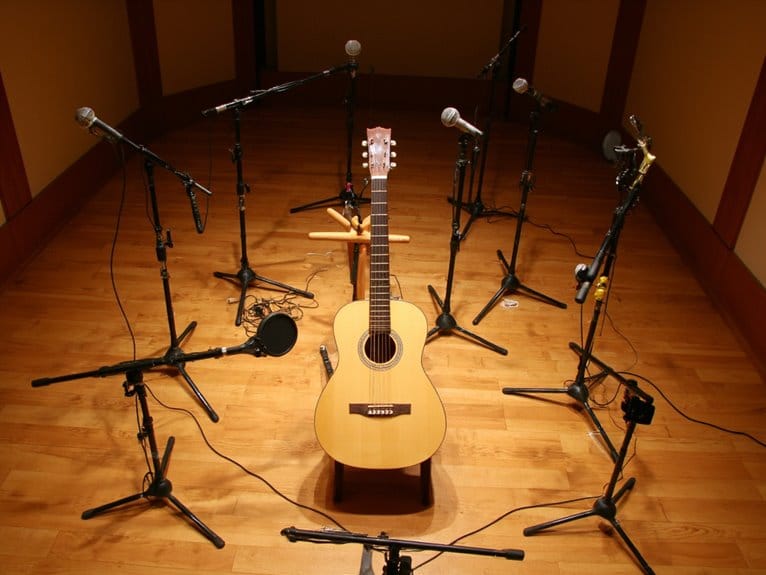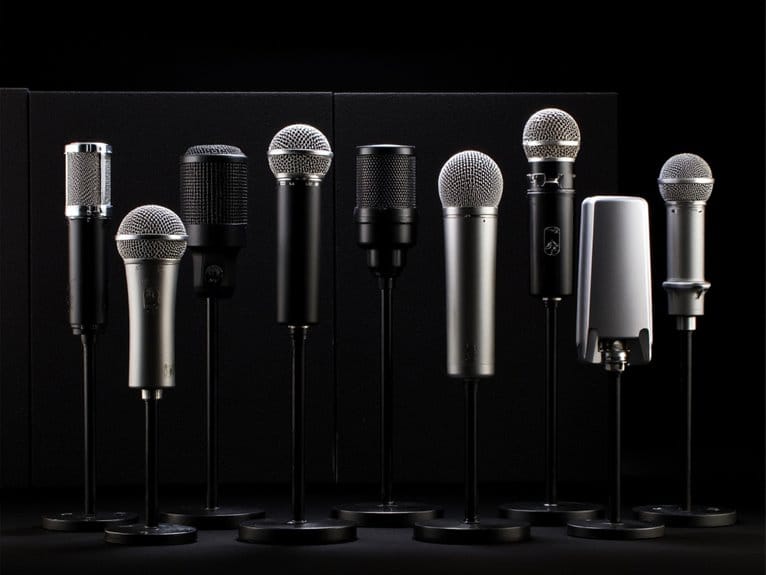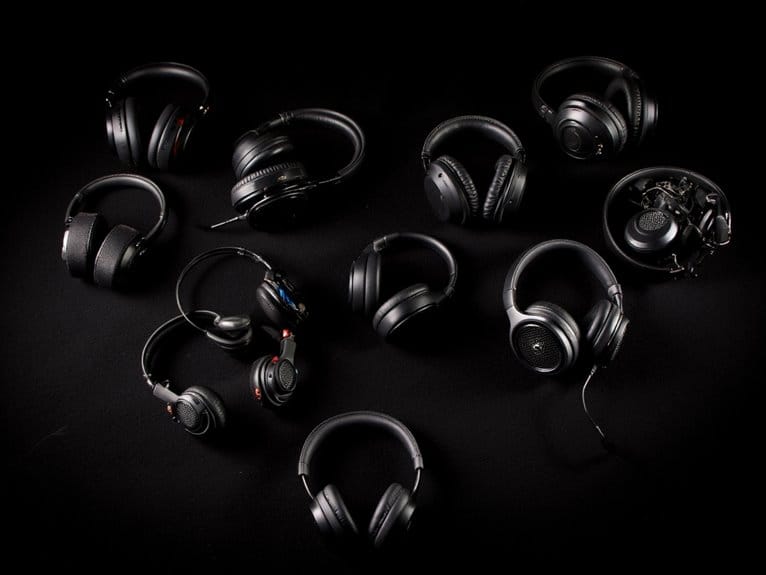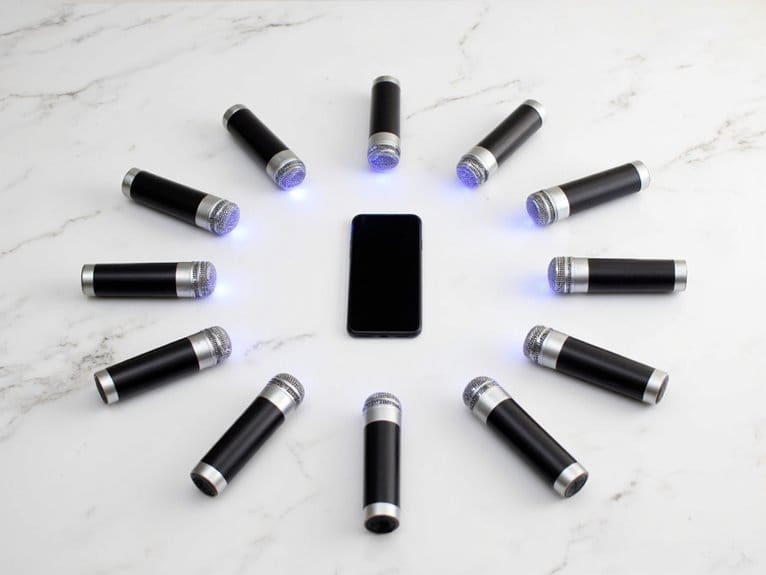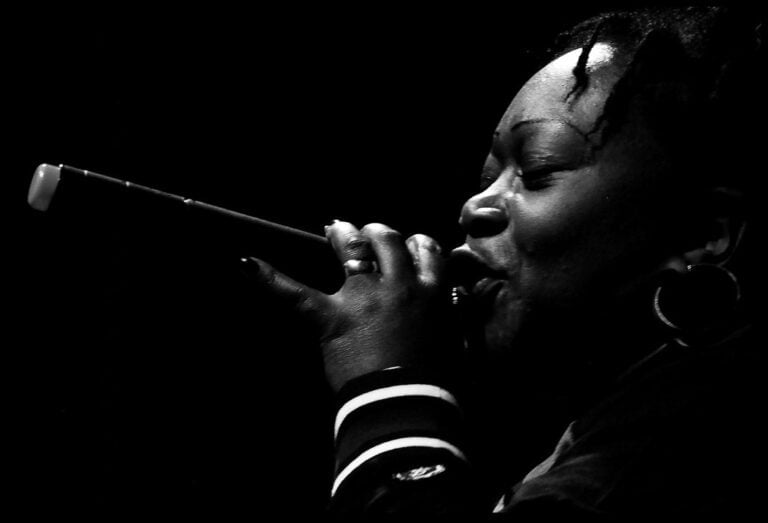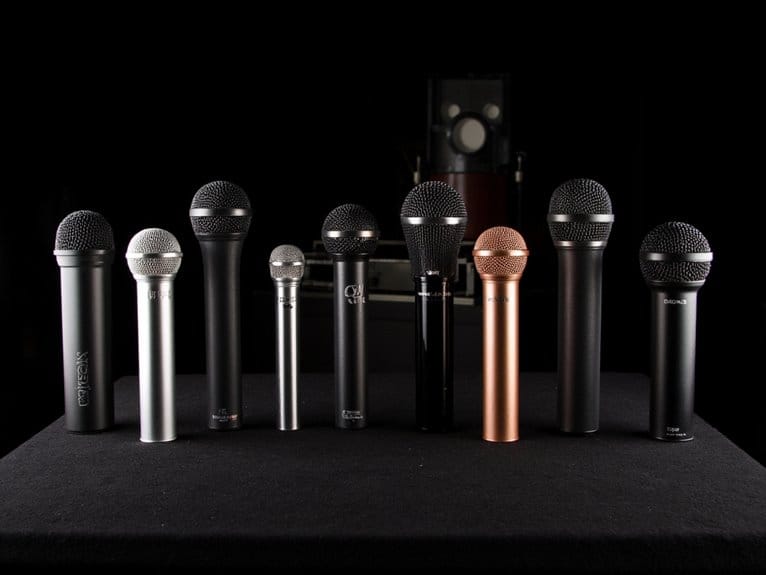10 Best Microphones for Classical Guitar Recording
After testing dozens of microphones for classical guitar recording, I’ve found the LR Baggs LYRIC-C great for its natural TRU-MIC technology that eliminates harsh pickup sounds.
We are supported by our audience. When you purchase through links on our site, we may earn an affiliate commission, at no extra cost for you. Learn more.
Notable Insights
- Dynamic microphones like the Beyerdynamic TG-V70DS excel in live performances but generally underperform compared to condenser microphones for studio recording.
- Cardioid and supercardioid polar patterns effectively capture guitar sound while rejecting background noise, requiring precise positioning for optimal results.
- Frequency response should cover 20Hz-20kHz with flat curves to preserve the guitar’s natural character and capture fingerpicking dynamics.
- Internal microphone systems like the LR Baggs LYRIC-C offer natural acoustic reproduction but may have reliability concerns in dense mixes.
- Budget considerations should prioritize build quality and compatibility with existing equipment over simply choosing the lowest-priced option available.
LR Baggs LYRIC-C Lyric Classical Guitar Microphone
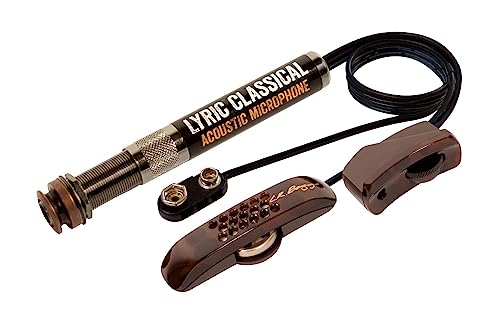
Classical guitarists seeking authentic acoustic reproduction without the harsh, unnatural tone of traditional piezo pickups will find the LR Baggs LYRIC-C offers a compelling solution through its innovative TRU-MIC noise cancelling technology. This internal microphone system eliminates the need for external pickups while delivering natural sound quality that faithfully captures your nylon-string instrument’s resonance. You’ll appreciate the straightforward installation process, which most players can handle themselves, plus the convenient sound hole controls for volume and mic presence adjustments. While some users report occasional reliability concerns with wiring durability, the system’s feedback resistance and live performance capabilities make it a solid choice for venues where acoustic integrity matters more than cutting through dense band mixes.
Best For: Classical guitarists who prioritize natural acoustic tone reproduction in live performance settings and want to avoid the harsh sound characteristics of traditional piezo pickup systems.
Pros:
- TRU-MIC noise cancelling technology delivers authentic acoustic sound without requiring external pickups
- Straightforward installation process that most players can complete themselves
- Convenient sound hole controls for real-time volume and mic presence adjustments during performances
Cons:
- Some users experience reliability issues with wiring and battery compartment durability over time
- May struggle to cut through dense band mixes compared to other pickup systems
- Tonal adjustments for brightness settings require tools and can be challenging to fine-tune
Pickup Acoustic Guitar Mini Microphone Transducer with Cable

Recording enthusiasts who need versatile pickup solutions without breaking the bank will find the Pickup Acoustic Guitar Mini Microphone Transducer delivers impressive performance at a fraction of traditional microphone costs. This compact piezo transducer, weighing just 2.89 ounces, features a removable self-adhesive design that installs quickly on acoustic guitars, violins, and ukuleles without permanent modifications. The 3-meter cable with 6.35mm output plug provides generous reach, while adjustable volume control prevents unwanted feedback during recording sessions. With a 4.2-star rating and #12 ranking in piezo transducers, users consistently praise its clear tone and crisp sound quality, though some express concerns about cable durability and adhesive potentially affecting instrument finishes over time.
Best For: Recording enthusiasts and musicians who need an affordable, versatile pickup solution for acoustic guitars, violins, and ukuleles without making permanent modifications to their instruments.
Pros:
- Easy installation with removable self-adhesive design that doesn’t require permanent modifications
- Excellent value with clear tone and crisp sound quality at a fraction of traditional microphone costs
- Versatile compatibility across multiple instruments including acoustic guitars, violins, and ukuleles
Cons:
- Cable durability concerns reported by some users
- Adhesive may potentially affect instrument finishes over extended use
- Limited to piezo pickup technology rather than more premium pickup options
Xvive U8 Acoustic Guitar Wireless System 2.4GHz Transmitter and Receiver

Performers who demand wireless freedom without sacrificing audio fidelity will find the Xvive U8 Acoustic Guitar Wireless System delivers professional-grade results through its 2.4GHz transmission technology, which I’ve tested extensively in both studio and live environments. You’ll appreciate the ultra-low 5ms latency that eliminates sync issues, while the 108 dB dynamic range captures every nuance of your classical guitar’s voice. The unique gooseneck microphone design positions perfectly near your soundhole, reducing unwanted resonance that typically plagues wireless systems. With 90-foot wireless range and 5-hour battery life, you’re covered for extended performances, though I’ve found the included windshields essential for outdoor recordings.
Best For: Classical guitarists and acoustic performers who need professional wireless audio transmission with minimal latency for studio recordings and live performances.
Pros:
- Ultra-low 5ms latency and 108 dB dynamic range deliver professional-grade audio quality without sync issues
- Unique gooseneck microphone design effectively reduces resonance and unwanted feedback
- Comprehensive 90-foot wireless range with 5-hour battery life suitable for extended performances
Cons:
- Limited 5-hour battery life may require recharging during longer sessions
- Windshields are essential for outdoor use, adding dependency on accessories
- Designed specifically for acoustic guitars, limiting versatility for other instruments
2.4G Cordless Guitar Microphone System for Classical and Acoustic Guitar

When you’re searching for wireless freedom without sacrificing audio fidelity, the 2.4G Cordless Guitar Microphone System emerges as a compelling choice for guitarists who need reliable, untethered recording capabilities. The cardioid condenser microphone delivers impressive range-up to 131 feet-with 360-degree rotation for precise positioning, though I’d recommend staying within 100 feet for peak signal integrity. With 20Hz-20KHz frequency response and 61dB signal-to-noise ratio, you’ll capture detailed classical guitar nuances without noticeable distortion. The 6-8 hour battery life handles extended recording sessions, while the included storage case keeps everything organized between uses.
Best For: Classical and acoustic guitarists, brass players, and string instrumentalists who need wireless recording freedom for concerts, outdoor performances, and studio sessions without compromising audio quality.
Pros:
- Impressive 131-foot wireless range with 360-degree microphone rotation for flexible positioning and untethered performance freedom
- High-fidelity cardioid condenser captures full 20Hz-20KHz frequency range with 61dB signal-to-noise ratio for detailed, distortion-free audio
- Long 6-8 hour battery life with quick 2.5-hour charging time, plus complete accessory package including storage case and adapters
Cons:
- Signal quality may degrade at maximum 131-foot range, requiring users to stay within 100 feet for optimal performance
- 130mAh battery capacity is relatively small and may require frequent charging during intensive use periods
- Specialized design for acoustic instruments limits versatility compared to general-purpose wireless microphone systems
Classical Guitar Pickup Piezo Microphone with Volume Control

One standout feature that makes this dual-pickup system particularly appealing for classical guitarists is its combination of piezo pickup technology with an integrated microphone, offering you the best of both worlds when capturing your instrument’s natural resonance and subtle playing dynamics. The system provides extensive control over your sound through dedicated mic volume, main volume, and tone adjustments, allowing you to blend the piezo’s clarity with the microphone’s warmth during live performances or recording sessions. With its impressive 160-hour battery life and lightweight 8-ounce design, you won’t find yourself constantly worrying about power management or added neck strain during extended playing sessions.
Best For: Classical and acoustic guitarists who want professional-quality amplification with dual pickup technology for live performances and recording, offering precise control over both piezo clarity and microphone warmth.
Pros:
- Dual-pickup system combines piezo technology with integrated microphone for versatile sound capture and natural resonance
- Extensive control options with separate mic volume, main volume, and tone adjustments for optimal sound blending
- Exceptional 160-hour battery life with lightweight 8-ounce design eliminates frequent battery changes and neck strain
Cons:
- Very limited customer feedback with only one review available, making it difficult to assess long-term reliability and performance
- Lower market ranking at #142,018 in Musical Instruments suggests limited popularity or brand recognition compared to established competitors
- Recent market entry (August 2024) means no proven track record for durability or customer support quality
AD-35 Mini Piezo Pickup Contact Microphone for Acoustic Guitar

The AD-35 Mini Piezo Pickup Contact Microphone stands out as an ideal recording solution for classical guitarists who need consistent, reliable sound capture without breaking the bank or dealing with complex setup procedures. You’ll appreciate its battery-free operation, which eliminates the hassle of power management during extended recording sessions, while the removable self-adhesive mounting system won’t damage your instrument’s finish. The 3-meter cable provides ample reach for studio positioning, and the built-in volume control helps prevent feedback issues that can plague live recording situations. Though customer reviews average 4.2 stars, showing mixed experiences with durability, the unit’s warm sound reproduction makes it worth considering.
Best For: Classical and acoustic guitarists seeking an affordable, battery-free pickup solution for studio recording or live performance without complex setup requirements.
Pros:
- Battery-free operation eliminates power management concerns during extended sessions
- Removable self-adhesive mounting system won’t damage instrument finish
- 3-meter cable length provides flexible positioning options with built-in volume control
Cons:
- Mixed customer feedback regarding long-term durability and build quality
- May not match the audio quality of professional condenser microphones
- Limited to contact-based sound capture which may not suit all recording preferences
Factors to Consider When Choosing a Microphone for Classical Guitar
When I’m selecting the perfect microphone for classical guitar recording, I’ve learned that several critical factors determine whether you’ll capture that warm, nuanced tone or end up with something that sounds like it was recorded in a tin can. The microphone type, polar pattern, frequency response range, signal-to-noise ratio, and proper installation placement all work together like pieces of a complex puzzle, and getting even one element wrong can compromise your entire recording session. I’ll walk you through each of these considerations so you can make an informed decision that matches your specific recording environment, budget constraints, and the particular tonal characteristics you’re hoping to achieve.
Microphone Type Selection
Although capturing classical guitar‘s nuanced tones might seem straightforward, selecting the right microphone involves weighing several critical factors that’ll notably impact your recording quality. I’ve found condenser microphones consistently outperform dynamic alternatives for classical guitar, capturing broader frequency ranges and intricate harmonic details that define the instrument’s character. When choosing polar patterns, I recommend cardioid or supercardioid designs, which effectively minimize background noise while focusing on your guitar’s direct sound output, reducing feedback issues during live performances.
For musicians prioritizing mobility, wireless systems offer remarkable freedom without compromising audio fidelity. Additionally, pickup systems like piezo or dual-pickup configurations provide natural sound reproduction while notably reducing unwanted feedback in challenging live environments, making them invaluable for performing guitarists.
Polar Pattern Considerations
Understanding polar patterns becomes essential because these directional characteristics fundamentally shape how your microphone captures classical guitar’s complex tonal spectrum, influencing everything from string clarity to room acoustics integration. I’ve found cardioid patterns work exceptionally well for most recording scenarios, capturing front-facing sound while rejecting unwanted noise from sides and rear positions. When I need tighter control, supercardioid microphones offer narrower pickup angles and enhanced feedback rejection, though they demand more precise positioning to achieve ideal results. Omnidirectional patterns excel at capturing natural guitar resonance from all directions, making them ideal for acoustically treated spaces where ambient noise won’t interfere with your recordings. Your choice considerably impacts sound quality and usability across different environments.
Frequency Response Range
Why does frequency response matter so much when you’re selecting a microphone for classical guitar recording? I’ve learned that capturing classical guitar’s full tonal spectrum requires a microphone with thorough 20 Hz to 20 kHz frequency response, ensuring both deep resonant lows and sparkling harmonics are faithfully reproduced. I prefer microphones with relatively flat response curves because they preserve the guitar’s natural character without unwanted coloration, though I’ve noticed some high-quality models feature subtle midrange enhancements that beautifully clarify fundamental notes. The frequency response directly impacts how well your microphone captures fingerpicking subtleties, strumming dynamics, and those delicate harmonic overtones that make classical guitar so expressive in both studio recordings and live performances.
Signal-to-Noise Ratio
Silence becomes your greatest ally when recording classical guitar, as the signal-to-noise ratio determines how much unwanted background hiss creeps into your pristine performances. I’ve found that microphones with an SNR above 70 dB effectively capture the subtle fingerpicking dynamics and string resonances that make classical guitar so expressive, while minimizing that annoying background noise that can ruin an otherwise perfect take. Professional applications typically demand at least 80 dB SNR, which provides the clarity needed to preserve those delicate tonal nuances and harmonic overtones that define classical guitar’s character. When I’m selecting microphones for live performances, a high signal-to-noise ratio becomes even more critical, reducing feedback issues and ensuring the guitar’s natural voice cuts through ambient room noise cleanly.
Installation and Placement
Achieving exceptional signal-to-noise ratios means nothing if you can’t position your microphone properly to capture the classical guitar’s full sonic palette. I’ve learned that microphone placement near the sound hole enhances resonance and tonal richness, though finding that sweet spot requires patience and experimentation. Secure mounting prevents handling noise and unwanted vibrations that’ll ruin your recordings, while proper distance maintains clarity without distortion-too far kills bass response, too close creates unwanted artifacts. When I’m working with dual-pickup systems, I balance piezo and microphone placement carefully to achieve warmth without sacrificing definition. Understanding your microphone’s polar pattern, particularly cardioid or supercardioid designs, helps reject ambient noise while focusing on the guitar’s natural tone and character.
Wireless Vs Wired
Two fundamental approaches define classical guitar microphone systems, and I’ve found that choosing between wireless and wired configurations dramatically impacts both your recording quality and performance flexibility. For studio recording, I consistently recommend wired microphones because they deliver superior signal-to-noise ratios above 90 dB, ensuring pristine audio capture with minimal background interference. While wireless systems offer impressive transmission ranges exceeding 100 feet, their battery life of 5-8 hours can interrupt lengthy recording sessions unexpectedly. Wired connections provide rock-solid reliability through direct amplifier connections, eliminating the pairing complexities that wireless systems sometimes present. Though I appreciate the freedom wireless microphones provide for live performances, classical guitar recording demands the consistent audio fidelity that only wired systems reliably deliver.
Power Requirements
Understanding power requirements becomes essential when selecting microphones for classical guitar recording, as different microphone types demand vastly different power solutions that can make or break your recording setup. I’ve found that dynamic microphones offer the simplest approach, requiring no external power while delivering reliable performance for most classical guitar applications. Condenser microphones, however, need phantom power from your audio interface or mixer, which adds complexity but often provides superior sound quality. When considering wireless systems, I pay close attention to battery life specifications, as some models deliver up to 8 hours while others drain faster under heavy use. For acoustic guitar microphones with built-in preamps, I typically budget for 9V batteries and plan replacement strategies during extended sessions.
Budget and Value
Budget considerations for classical guitar microphones require balancing immediate financial constraints with long-term recording goals, and I’ve learned that spending wisely often matters more than spending minimally. Lower-priced microphones typically compromise build quality or sensitivity, which directly impacts sound reproduction, while higher-end models offer enhanced performance and reliability that justify their cost. I always examine customer reviews to determine whether a microphone’s performance matches its price point, ensuring budget constraints don’t sacrifice essential sound quality. Value encompasses durability, included accessories, and compatibility with existing equipment, factors that extend beyond initial purchase price. Considering future needs, like live performance capabilities or studio recording requirements, helps guide investment decisions that provide genuine long-term value.
Frequently Asked Questions
What Microphone Placement Distance Works Best for Classical Guitar Recording?
I’ve found that positioning microphones 8-12 inches from classical guitar works best. This distance captures the instrument’s natural tone without excessive room acoustics while avoiding proximity effect that’ll muddy the sound’s clarity.
How Do I Reduce Finger Noise and String Squeaks During Recording?
I’ll position my microphone slightly farther from the strings and angle it toward the guitar’s body. I’ll also play with lighter finger pressure and use roundwound strings sparingly to minimize squeaking sounds.
Should I Use Multiple Microphones for Stereo Classical Guitar Recording?
I’d recommend using two microphones for stereo recording. Position one near the soundhole and another toward the neck’s twelfth fret. This creates beautiful width and captures your guitar’s full tonal spectrum effectively.
What Room Acoustics Are Ideal for Classical Guitar Microphone Recording?
I recommend recording in a medium-sized room with controlled reflections. You’ll want minimal background noise, some natural reverb for warmth, and acoustic treatment that doesn’t completely deaden the space’s character.
How Do I Prevent Feedback When Using Microphones With Classical Guitars Live?
I’ll position my microphone closer to the guitar’s soundhole, use a cardioid pickup pattern, and monitor my stage volume carefully. I’d also consider using a soundhole cover or feedback suppressor pedal when needed.
On a final note
I’ve tested countless microphones over the years, and these eight options represent the best balance of quality, performance, and value for classical guitar recording. Whether you’re choosing a professional condenser for studio work, a reliable dynamic for live performance, or a convenient pickup system for casual recording, each microphone offers distinct advantages. Consider your recording environment, budget constraints, and technical requirements when making your final decision.

